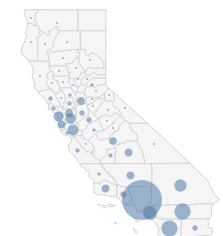- We’re Back! 2025
- Mardi Gras 2025 “Long Beach Shorline”
- NFL 2023-2024 Schedule
- Venice Beach Muscle Competition
- Gelato Festival World Masters
- LA Beer Fest 2023
- Organic Harvest Gardens Sunday Brunch
- Jazz on the Grass 2023
- Leimert Park Jazz Festival 2023
- Cookbook & Dinner
- Ocean Water Use Warning for LA Beaches
COVID-19 cases by the numbers in California

COVID-19 by the numbers as of May 11, 2020, there are a total of 67,939 positive cases and 2,770 deaths in California.
L.A. County’s stay-at-home order will likely remain in place for the next three months unless there is a “dramatic change to the virus and tools at hand,” officials say.
Los Angeles County officials are recommending that the stay-at-home order be extended for the next three months as the region continues efforts to reduce the spread of the coronavirus.
At a Board of Supervisors meeting on Tuesday, county Public Health Director Dr. Barbara Ferrer said the order will “with all certainty” be extended unless there is a “dramatic change to the virus and tools at hand.”
Ferrer’s comments came during a debate over how long the county’s moratorium on evictions should remain in place.
Last month, officials extended the county’s “safer at home” order until at least May 15. The region’s reopening would be based on a four-point plan whose prerequisites would have to be achieved before the easing of restrictions began.
What is Social Distancing?
Social distancing is a practice recommended by public health officials to stop or slow down the spread of contagious diseases. It requires the creation of physical space between individuals who may spread certain infectious diseases. The key is to minimize the number of gatherings as much as possible and to achieve space between individuals when events or activities cannot be modified, postponed, or canceled. Achieving space between individuals of approximately six feet is advisable. Additionally, there is a particular focus on creating space between individuals who have come together on a one-time or rare basis and who have very different travel patterns such as those coming from multiple countries, states or counties.
Protect Yourself
How can people protect themselves?
There is currently no vaccine to prevent COVID-19. The best way to prevent illness is to avoid being exposed to this virus. The virus spreads mainly from person-to-person between people who are in close contact with one another (within about 6 feet). This occurs by respiratory droplets produced when an infected person coughs or sneezes. These droplets can land in the mouths or noses of people who are nearby or possibly be inhaled into the lungs. Surfaces can also get infected. Older adults and people who have severe underlying medical conditions like hypertension, obesity, heart or lung disease , diabetes or asthma seem to be at higher risk for developing more serious complications from COVID-19 illness. Every person has a role to play. So much of protecting yourself and your family comes down to common sense:
- Stay home except for essential needs/activities.
- Practice physical distancing – stay 6 feet away from people.
- Wear a cloth face mask if you leave home.
- Wash hands with soap and water for at least 20 seconds.
- Clean and disinfect frequently touched surfaces daily. If surfaces are dirty, clean them using detergent or soap and water prior to disinfection.
- Avoid touching eyes, nose or mouth.
- Cover your cough or sneeze with a tissue or your elbow or a tissue. Wash hands afterwards.
- Avoiding close contact with people who are sick.
- Stay home and away from people if you become sick with respiratory symptoms like fever and cough.
- If you smoke or vape, consider quitting. Smoking and vaping causes harm to the lungs.
- Follow guidance from public health officials.
Who is at Higher Risk for Serious Illness from COVID-19?
Early information out of China, where COVID-19 first started, shows that some people are at higher risk of getting very sick from this illness. This includes:
-
- Older adults (65+)
- Individuals with compromised immune systems
- Individuals who have serious chronic medical conditions like:
- Heart disease
- Diabetes
- Lung disease
- Smokers
If you are at higher risk for serious illness from COVID-19 because of your age or health condition, it is important for you to take extra actions to reduce your risk of getting sick with the disease:
-
- Stay home. It’s the most important thing you can do.
- Avoid contact with people who are sick. Isolate anyone sick in your home in a separate room, if possible.
- Consider ways of getting food brought to your house through family, social, or commercial networks. Wipe off containers with disinfectant wipes.
It is also important that you listen to public health officials who may recommend community actions to reduce potential exposure to COVID-19, especially if COVID-19 is spreading in your community.
What are the symptoms of COVID-19?
Typically, human coronaviruses cause mild-to-moderate respiratory illness. Symptoms are wide ranging and can be similar to the flu, including:
-
- Fever
- Cough
- Shortness of breath
- Chills
- Repeated shaking with chills
- Muscle pain
- Headache
- Sore Throat
- New loss of taste or smell
COVID-19 can cause more severe respiratory illness. If you have any of the emergency warning signs listed below, you should contact your medical provider immediately:
- Trouble breating
- Persistent pain or pressure in the chest
- New confusion
- Bluish lips or face







